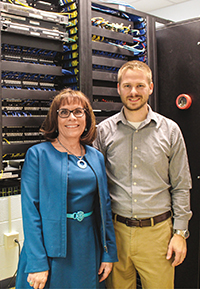The Homework Gap: In Pursuit of Web Access
May 01, 2020
Educators seek solutions, sometimes in personal ways, to the digital inequities that shortchange one-to-one initiatives for students in need

April Tidwell, principal of West High School in Sioux City, Iowa, has added a new chore to her job description over the past few years. Two or three mornings a week when school is in session, she picks up students at their homes on her way to work so
they can get there early. In the evenings, well after the last late buses have come and gone, she carts them back home.
That extraordinary personal touch is an unexpected — and hopefully temporary — byproduct of the digital
revolution. All middle and high school students in the 15,000-student Sioux City Community School District have laptops that they take home each day for homework and study. But nearly a third — including some 400 students in Tidwell’s
school alone — have no high-speed internet at home.
This Content is Exclusive to Members
AASA Member? Login to Access the Full Resource
Not a Member? Join Now | Learn More About Membership
Author
Additional Resources
Here is a sampling of resources available for school districts looking to narrow or eliminate the homework gap.
- Center for Digital Education: This research and advisory institute produced a 2019 handbook, “Closing the Connectivity Gap."
- CoSN: The Consortium for School Networking prepared a 28-page toolkit titled “Digital Equity: Supporting Students & Families in Out-of-School Learning.” It shares strategies for closing the homework gap and collaborating with the community to increase digital access.
- Eliminate the Digital Divide: A grassroots organization in Charlotte, N.C., teamed with the Charlotte-Mecklenburg School District and local companies to provide students with decommissioned (and repaired) corporate computers and digital literacy workshops and mentoring.
- EveryoneOn: The nonprofit works with organizations and internet service and device providers to connect low-income families with low-cost home internet service, computers and tablets, and digital literacy training.
- Future Ready Schools: This is a project of the Alliance for Excellent Education, which works with school leaders to target inequities among students in technology inside and outside schools.
- International Society for Technology in Education: This organization has published a book series, “Closing the Gap,” on achieving digital equity in education.
- Schools, Health & Libraries Broadband Coalition: This group advocates for open and affordable broadband connections for schools and libraries. It hosts webinars, among other services.
Bringing High-Speed Service to Remote Areas

PHOTO COURTESY OF KENT COUNTY, MD., PUBLIC SCHOOLS
Jordyn Cox-Pemberton, a high school junior in the Kent County Public Schools on Maryland’s Eastern Shore, remembers her days in middle school when computers were kept on roaming carts and her internet at home was spotty at best.
Today,
she takes home her school-issued laptop and enjoys lightning-fast internet service of 1,000 megabits per second at both school and home.
“Now I can take my homework with me — my classwork — so I can look up everything
I didn’t understand in class earlier,” she says.
Kent County, which hugs the Chesapeake Bay, is subject to two key causes of the homework gap: families that can’t afford high-speed internet at home and those who live in
rural areas where it is simply not available. But that situation is changing fast.
Bolstering Bandwidth
In 2013, a county government committee decided creating a broadband infrastructure would be the key to boosting the local economy. The effort got an unexpected boost as a company running fiber optic cable to the Atlantic coast reached a deal to extend
the cable through Kent County. The county completed the 110-mile fiber backbone in 2018.
Officials worked from that backbone to wire public buildings, including the schools, which were already embarking on a one-to-one technology program.
The fiber supercharged the district’s technology offerings.
“If you have a classroom of 25 or 30 students who are viewing virtual reality environments, that typically will bog down your bandwidth and you’re not going to
be able to have a full class of students doing that,” says Bill Poore, technology supervisor of Kent County School District. “Now, with the fiber, that’s not a problem.”
Karen Couch, superintendent of the 2,000-student
district, says student interest has soared with the growth of technology camps, makerspace and hackerspace clubs, coding courses in the middle school and two Advanced Placement computer science courses.
If the county hadn’t spearheaded
the fiber project, Couch says, “it would have drastically crippled our ability to move forward as quickly as we have.”
Still, the district’s ultimate solution to the homework gap remains a work in progress. Connecting
cable and Wi-Fi from the backbone to distant parts of the county is a slow process. Some of Cox-Pemberton’s high school friends still aren’t connected and not all residents can afford the installation and service charges.
Rural Reduction
Scott Boone, director of information technology for Kent County, Md., tirelessly shepherded the fiber project and thought he was on the fast track to closing the homework gap with Wi-Fi and hotspots that would be affordable to low-income families.
But last summer, in a blow to rural school districts across the country, the Federal Communications Commission chose to auction licenses for the Educational Broadband Service spectrum on the open market rather than favoring schools. That has
created a “battle for the airwaves” with private companies that makes it more difficult to connect rural families, Boone says.
The nonprofit Schools, Health & Libraries Broadband Coalition says if the FCC had assigned the
broadband service licenses to schools and tribal nations, it could have reduced the homework gap nationally by nearly 30 percent.
“What could have been the silver bullet for closing the digital divide, especially in rural areas, was
just taken away,” says Boone, a coalition board member.
The county’s project continues, though. It has rolled out some ambitious fixes, including 70 anchor sites with fiber access in gathering places across the county such as
public libraries, community centers and even beaches. Cox-Pemberton says she makes use of one of those sites when she wants to study with friends who don’t yet have fiber at home.
“We head to the Kent County library, and they
have great internet access there,” she says.
Advertisement
Advertisement
Advertisement
Advertisement



